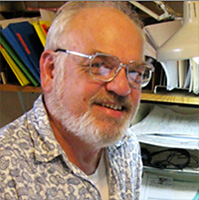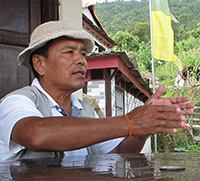“The View from Birauta” by Don Messerschmidt (Nepal)
 When Don Messerschmidt (Nepal 1963-65) graduated from the University of Alaska/Fairbanks, cass of 1963, he was only vaguely aware of the Kingdom of Nepal. With a degree in education he thought he’d become a teacher in the Alaskan bush. But, by accepting an invitation to join the Peace Corps that summer, his life changed dramatically. By September he was in Nepal doing development work in the (then) remote central hills. Since 1963, Don has lived and worked in the Himalayas as a development advisor, anthropological researcher, teacher, and writer/editor.
When Don Messerschmidt (Nepal 1963-65) graduated from the University of Alaska/Fairbanks, cass of 1963, he was only vaguely aware of the Kingdom of Nepal. With a degree in education he thought he’d become a teacher in the Alaskan bush. But, by accepting an invitation to join the Peace Corps that summer, his life changed dramatically. By September he was in Nepal doing development work in the (then) remote central hills. Since 1963, Don has lived and worked in the Himalayas as a development advisor, anthropological researcher, teacher, and writer/editor.
The epicenter of Nepal’s April 2015 Gorkha Earthquake was very near Don’s Peace Corps village. After the quake, he returned twice to help with the recovery work and documentation, under auspices of the all-volunteer non-profit Gorkha Foundation. As a member of the Board of Advisors, Don helps raise funds for rebuilding schools destroyed in the quake. Don can be contacted at dmesserschmidt@gmail.com.
A slightly amended version of this story was published in the April 2016 edition of Aurora, the University of Alaska/Fairbanks alumni magazine.
•
The View from Birauta
by Don Messerschmidt
The great Nepal Earthquake of 2015 struck the central hill district of Gorkha at 11:56 o’clock on a balmy Saturday morning, April 25th. The devastating tremor registered 7.6 on the Richter scale, and lasted 55 seconds—an eternity when the earth convulses so wildly that you can’t stand up. For the next six months over 400 aftershocks rocked Nepal, some as strong as magnitude 6.6.
The tragedy and trauma experienced in the Nepalese hinterland and in Kathmandu, is beyond measure. Close to 9,000 people have died, another 18,000 were injured, and many are still unaccounted for. In Gorkha District, 80 percent of the schools collapsed, but because they were empty on that weekend holiday, a much higher death toll was averted. The villagers immediately began picking up the pieces and have moved on with remarkable resilience and determination to rebuild their homes, their schools, and their lives.
The morning of the quake, Suman Gurung, a 16-year old schoolboy, was out grazing the family cows in the forest. After he and his friend Anil had climbed a box myrtle tree to gather kaphal fruits (bay berries), they heard a sudden roar and felt a jarring motion. Anil shouted, “Stop shaking the tree!” and Suman said, “No. You stop!” Then they lost their grip tumbled to the ground where they clung to a sapling to keep from falling over. “I didn’t know what to do,” Suman recalls. “I was so scared, it felt like my heart fell out.”
When the shaking stopped the boys ran home to scenes of utter devastation. Their parents, siblings and neighbors were outside crying. Large cracks had split open the walls of their homes, slate roofs had fallen in, and stored grain baskets had burst open. Because village houses are typically constructed of stone with mud mortar, many had collapsed to heaps of rubble. Fortunately, while there were some injuries, nobody died in their small village. But sharp aftershocks during the afternoon and evening prolonged their terror. Late in the day, Suman went back to bring in the cows. By then it was raining, and along the way he slipped and fell. It was a frightful time.
Suman lives in Birauta, a village of several dozen houses. A few weeks after the quake, a Nepalese companion and I went there to see the village primary school in ruins. At the school site we met members of the school committee — the middle-aged principal, the young school board chairman, and an older gentleman who also served as the village headman. They showed us a grim site. The roof and parts of the walls had collapsed, most of the school furniture was smashed, and colorfully illustrated primers were strewn across the floors in a mish-mash of rain-soaked pages.

Temporary school
A temporary school had been set up nearby under two dark, military grade tents donated by an international relief agency. There the school children greeted us cheerily from benches that had been recovered from the rubble and repaired. That’s where we met Suman and heard his story.
The community leader, who had introduced himself as Govinda Gurung, a Subedar (Captain) recently retired from the Indian Army, suggested that we continue on up the mountainside to see the rest of the village. Along the way he pointed out damaged homes, and he was greeted by the residents who quite clearly had great respect for him.

The last house standing
Near the middle of the village we rounded a corner and came face to face with what seemed starkly out of place — a modern two-story house made of concrete, and painted white with a reddish-brown trim, undamaged. When we expressed surprise, Govinda explained that he had recently built it with his life savings and some of his pension paid annually by the Indian government. It was his home, he said.
How remarkable, we thought, that a house such as his, which looked like it belonged in urban Kathmandu, had been built in this remote place, and that it had withstood the quake virtually unscathed. Surrounded by so much devastation, it appeared to be “the last house standing.”
Govinda invited us for tea on his veranda, from which we could see more of the earthquake damage. Soon, his smiling wife appeared with a tray laden with sweet, milky chiya in fancy porcelain tea cups, a plateful of fresh hot, sweet rice flour donuts called sel roti, and spicy grilled meat called cheula. We thanked them for their generous hospitality, knowing that had we courteously demurred, Govinda would have reminded us that serving guests was his proud duty as the village leader and as a Gurkha officer.

Govinda Gurung
While we enjoyed the mid-afternoon snack, Govinda described his vision of the future. He would move the village to a safer location, he said, where every house would have electricity and piped water and would be constructed like his, to survive future earthquakes.
Later, as we set out to return to the village where we were encamped a half an hour’s walk around the mountain, Govinda accompanied us up to a high viewpoint overlooking Birauta. From there we could see many tents and tarps, some bright yellow, some blue, out on the open terraces, along with a few bamboo frame structures covered with CGI sheeting (corrugated galvanized iron, or ‘tin’, if you will).
“That’s where the homeless families now cook and eat, and sleep,” he said.
Then, to our surprise, “My tent is also there,” he added. “It’s where I sleep at night.”
“Why?” we asked. “Why don’t you go home? Why stay out in the rain, the mud and the leaches? Why not sleep in your safe, dry house?”
Govinda’s reply reveals a great deal about his character, about the sort of leader he is, and about empathy and selflessness: “It wouldn’t look right for me to sleep at home,” he quietly told us, “when all my neighbors are out there in the open.”
It is winter in Himalayas now, and in Birauta and other villages many people are still living under temporary shelters in the bitter cold. For them, the earthquake is far from over.
No comments yet.
Add your comment